![]()
![]()
![]()
Use LEFT and RIGHT arrow keys to navigate between flashcards;
Use UP and DOWN arrow keys to flip the card;
H to show hint;
A reads text to speech;
49 Cards in this Set
- Front
- Back
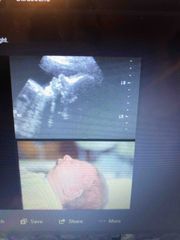
What dx? |
Pierre Robin syndrome- prominent micrognathia. It’s a facial abnormality including micrognathia which cause tongue to retract and cause breathing problems. |
|
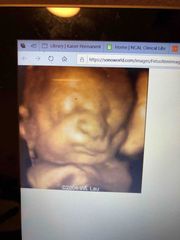
Diagnosis? |
Treacher Collins syndrome. Malformation of facial features. Small jaw and chin, unusual formed ears. |
|
|
D |
D |
|
|
What’s Goldenhar’s syndrome associated with? What is the definition? |
Ears malformation. Definition- incomplete development of ears, nose, lip, soft palate, mandible and usually one side of the body. |
|
|
What are eat malformation associations? |
Goldenhar syndrome Hemifacial microsomia - abnormal smallness one side of the face. Robert syndrome - small ears Otocephaly - absence of mandible causing ears to form close together anteriorly and toward the neck. |
|
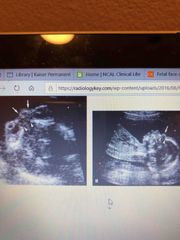
What do you see? |
Anterior cephalocele- Abnormal profile, hypertelorism. |
|
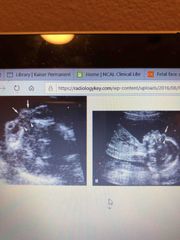
What do you see? |
Anterior cephalocele- Abnormal profile, hypertelorism. |
|
|
Midsagittal scan through face can allow you to evaluate what kind of pathology? |
Cloverleaf skull Frontal bossing Strawberry shaped cranium Masses of nose and upper lip |
|

What do you see? |
Anterior cephalocele- Abnormal profile, hypertelorism. |
|
|
Midsagittal scan through face can allow you to evaluate what kind of pathology? |
Cloverleaf skull Frontal bossing Strawberry shaped cranium Masses of nose and upper lip |
|
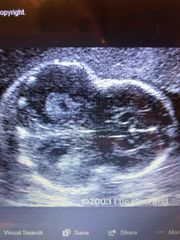
What’s the finding? What is it associated with? |
Cloverleaf skull Associated with ventriculomegaly, trigonocephalu, numerous skeletal dysplasia. |
|
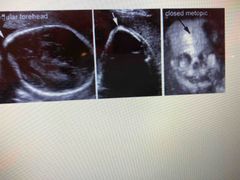
What’s the finding? |
Trigonocephaly: premature closure of me topic suture. Triangular only axial plane. |
|
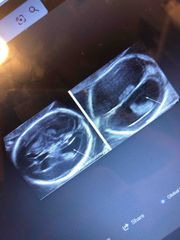
What’s the finding? |
Ventriculomegaly. |
|
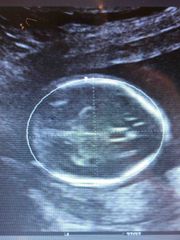
What’s the finding? |
Lemmon shapes skull. |
|
|
Midface hypoplasia is what? This finding is seen with? |
Depressed or absent nose. Seem with chromosomal abnormalities: Trisomy 21, craniosynostosis syndrome, Apert syndrome, Achondroplasia, chrons Rp dysplasia punctata, asphyxiating thoracic dysplasia. |
|
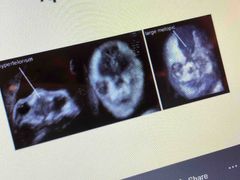
What’s the finding? |
Apert Syndrome- malformation ig face, hands, feet. Branchial arch syndrome— 1st branchial arch. Precursor to maxilla and mandible. |
|
|
What is achondroplasia? |
Bone growth disorder; cartilage doesn’t convert into bone- dwarfism |
|
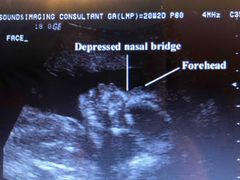
What is this finding associated under? |
Midface Hypoplasia means Depressed nasal bridge * Finding is: Achondroplasia (It’s a skeletal dysplasia) |
|
|
What is chndrodysplasia punctata? Associated with? |
It’s skeletal abnormality- Midface hypoplasia association. |
|
|
What is frontonasal dysplasia associated with? |
Median cleft syndrome: characterized by palate/ face cleft, hypertelorism. Essentially face defects. |
|
|
If NT is > 3mm what is this associated with? |
Chromosomal abnormality or defect. (Congenital heart disease). |
|
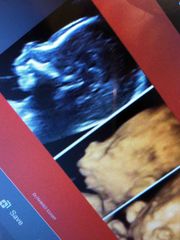
What’s the dx? |
Micrognathia |
|
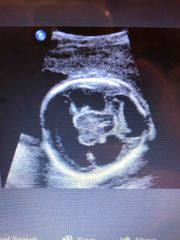
What’s this finding? Associated with? |
Holoprosencephaly. Associated with hypotelorism. |
|
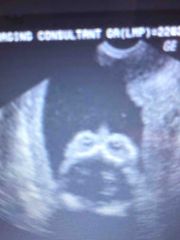
What’s this diagnosis? |
Hypotelorism |
|
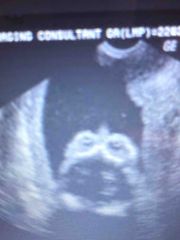
What’s this diagnosis? Associated with? |
Hypotelorism Associated with: holoprosencephaly, microcephaly, craniosyntoses, phenylketonuria, ventriculomegaly. |
|
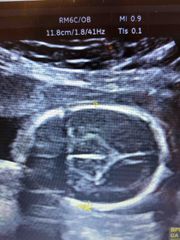
What’s the finding? Associated with? |
Microcephaly Hypotelorism |
|
|
What is the finding called when amino acid is elevated? |
Phenylketonuria |
|
|
What is the finding called when amino acid is elevated? This is also associated with? |
Phenylketonuria Hypotelorism |
|
|
Hypertelorism is associated with? Dilantin effects pregnancy in which ways? |
Chromosomal abnormalities, ventriculomegaly Dilantin affects with hypertelorism, microcephaly, cleft lip, CNS, skeletal anomalies. |
|
|
What’s the difference between microphthalmia and anopthalmia? |
Microphthalmia is small eyes. Anopthalmia is absent eyes. |
|
|
What’s the difference between microphthalmia and anopthalmia? |
Microphthalmia is small eyes. Anopthalmia is absent eyes. |
|
|
What is included with condition that have hypertelorism and premature suture closure? |
Crouzon syndrome, cephalosyndactyly, acrocephalopolysyndactyly, oculodentodigital dysplasia. |
|
|
What are considered characterizations of premature craniosynostoses? |
Crouzon syndrome |
|
|
What is acrocephalopolysyndactyly? |
Head deformity including webbed finger and toes |
|
|
What is acrocephalopolysyndactyly? |
Head deformity including webbed finger and toes |
|
|
What is oculodentodigital dysplasia? What are the common features? |
Affects body, particularly the eyes, teeth, fingers. Microphthalmia (small eyes) and other eye problems can lead to vision loss |
|
|
What is Holoprosencephaly? |
Brain and face abnormalities. Nasal anomalies range from absence of nice to presence of proboscis to single nostril nose. |
|
|
What is Holoprosencephaly? |
Brain and face abnormalities. Nasal anomalies range from absence of nice to presence of proboscis to single nostril nose. |
|
|
What’s cebocephaly and Arhinia? |
Cebacephaly- proboscis present to single nostril nose. Arhinia is a absent nose |
|
|
What is Holoprosencephaly? |
Brain and face abnormalities. Nasal anomalies range from absence of nice to presence of proboscis to single nostril nose. |
|
|
What’s cebocephaly and Arhinia? |
Cebacephaly- proboscis present to single nostril nose. Arhinia is a absent nose |
|
|
Who has a high risk to cleft palate and lip? |
Asians |
|
|
What is Holoprosencephaly? |
Brain and face abnormalities. Nasal anomalies range from absence of nice to presence of proboscis to single nostril nose. |
|
|
What’s cebocephaly and Arhinia? |
Cebacephaly- proboscis present to single nostril nose. Arhinia is a absent nose |
|
|
Who has a high risk to cleft palate and lip? |
Asians |
|

What’s this finding? |
Epignathus- complex mass with cystic and solid components rising from face / back with polyhydramnios. |
|
|
What’s potential mass in sublingual and submandibular ducts called? Differentials? |
Ranula & lymphangioma (cystic mass. Differential: Epilus, foregut duplicated cyst, branchial cleft cyst, salivary gland, macroglossia, beckwith weidemann syndrome, myoblastoma, cystic hygroma. |
|
|
What’s the most common neck abnormality? |
Cystic hygroma colli (lymphatic obstruction) |
|
|
What’s the most common neck abnormality? It causes a high risk for? What’s a defect? |
Cystic hygroma colli (lymphatic obstruction) Turners syndrome (high risk) Chromosomal defects |

